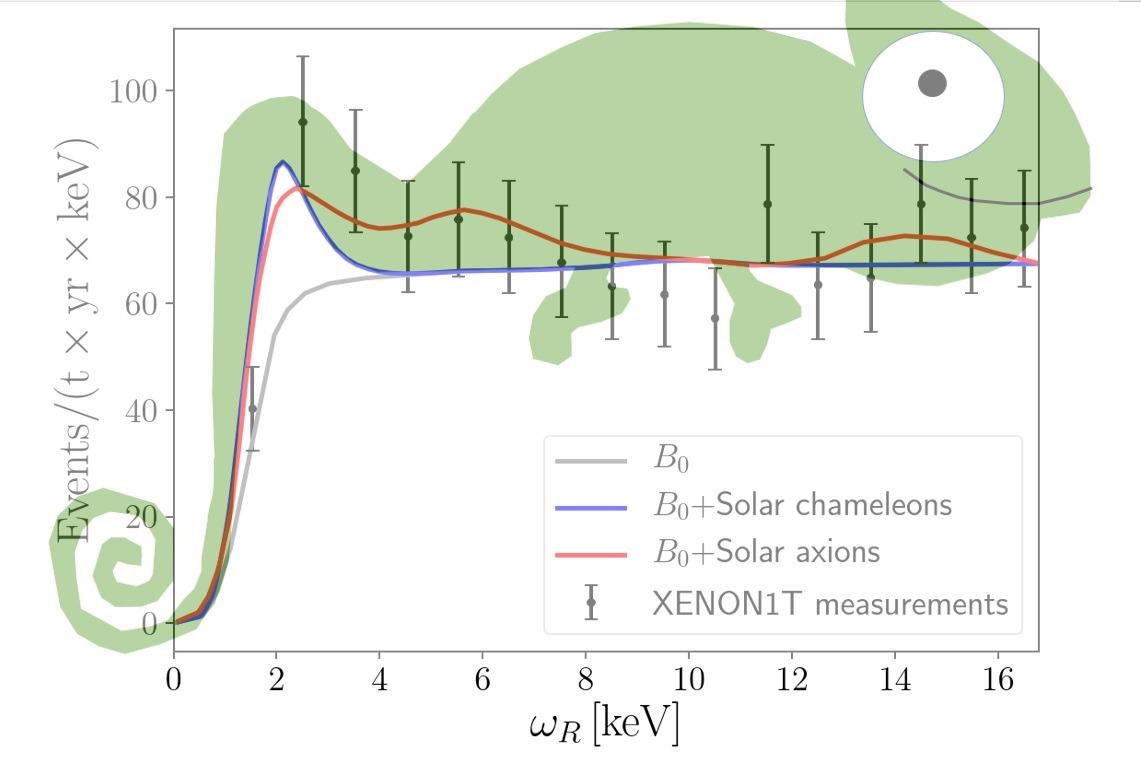AZoQuantum talks to Dr. Sunny Vagnozzi, a researcher at the University of Cambridge, about his work relating to the direct detection of dark energy.
How did you come to be involved in the study published last month on the potential detection of dark energy?
I've always been interested in ways of searching for dark energy which one could call “off the beaten track”, or let's say “out of the box”. Most importantly, I've recently been very interested in searching for non-gravitational signatures of dark energy: that is, signatures of dark energy making itself known in a way other than through its (repulsive) gravity.
In June 2020, the XENON1T experiment, a huge underground detector devoted to directly detecting dark matter, reported an excess of events above the expected background. This led to a flurry of research activity, with various groups throughout the world attempting to explain the signal, in the majority of cases invoking dark matter models.
I remember I was showering and, as I often do then, pondering about the signal and whether it could be explained in a way we could have missed so far.
One of the leading explanations for the XENON1T signal was in terms of solar axions – very light particles produced within the Sun.
Trouble is, if one wants solar axions to explain XENON1T, then these axions would be produced in copious amounts in stars which are denser than the Sun, drastically altering their evolution way beyond what is allowed by observations.
While pondering about this I realized an obvious way out of the problem was through so-called screening mechanisms. These screening mechanisms are typically associated to modified gravity and/or dark energy models. That was when I did 2+2 in my head and everything, at least at a conceptual level, clicked together: what if XENON1T actually saw dark energy? Of course, we then needed to confirm this at a quantitative level.
I soon got in touch with my close collaborator Luca Visinelli and we started looking at it together. We then got in touch with three experts on screening mechanisms: Phil Brax in Paris, Anne Davis in Cambridge, and Jeremy Sakstein in Hawaii. After over a year of work and several late Zoom calls (to accommodate the Hawaiian time zone), we managed to convince ourselves this could actually work, and our paper was finally published in September 2021.
Can you explain the difference between dark matter and dark energy, and how they both act upon our universe?
Most of the stuff out there in the Universe is not made of the visible matter we experience in everyday life, which makes up only 5% of the Universe's energy budget. The remaining 95% is divided into roughly 25% dark matter and 70% dark energy, whose existence we infer through their gravitational effects; in other words, the way their gravity affects stuff around them and the Universe as a whole.
Both dark matter and dark energy are supposedly dark. That is, they don't interact much (if at all) with photons, the particles of light. Beyond this, they don't have much in common. Broadly speaking, the gravitational effect of dark matter is attractive, while that of dark energy is repulsive.

Image Credit: Vadim Sadovski/Shutterstock.com
Dark matter is essentially the “glue” that holds the Universe together on the largest scales. Its role is to help form the structures we observe on the largest scales in the Universe (galaxies, clusters, superclusters, etc.), by providing that extra gravity to help these collapse in time for them to have formed by today.
Dark energy, on the other hand, pulls the Universe apart and makes its expansion accelerate. However, while dark matter has played a dominant role in the expansion of the Universe for the last 13 billion years, dark energy only started playing an important role about 1 billion years ago.
So on the largest scales, there is a sort of tug of war between dark matter and dark energy: the former would make the Universe's expansion decelerate, whereas the latter makes it accelerate. At the moment, it looks like dark energy is winning by a fair amount.
Why is it often difficult to collect data on dark energy?
Most of the searches for dark energy are only looking for its gravitational effects, as I alluded to above. One example is most cosmological searches, which are focused on constraining the so-called dark energy equation of state, the ratio between its pressure and energy density, which tells us the way dark energy's gravitational effects shape the expansion of the Universe.
In principle, one could learn a lot about dark energy by searching for non-gravitational signatures of dark energy interacting with ordinary matter. However, it is really difficult to know where to start when searching for such signatures, because the space of dark energy models is really vast, and there is no clear guiding principle.
Moreover, the simplest (but in a way also most problematic!) theoretical model for dark energy (the cosmological constant, or vacuum energy) does interact with anything else, so I think this has led to a bit of theoretical prejudice in that many commonly assume that dark energy will not interact with anything else. In this sense, we hope that our paper will lead to more research and open-mindedness in the quest towards searching for dark energy far and wide, including off the beaten track.
There are four well-known fundamental forces in the universe, however, an unknown fifth force is sometimes cited in research. What is meant by the ‘fifth force’ and how are models often equipped to hide this force?
Basically, anything which doesn't fall within the four fundamental forces (electromagnetism, gravity, strong force, weak force) is a “fifth force”.
The trouble is many extremely precise experiments have been devoted to search for these fifth forces, and have found no signs of it. So if a fifth exists, it must be hidden very well, at least on local scales where we know that Einstein's theory of gravity works extremely well (on the largest scales it's a totally different matter, as the Universe's accelerated expansion may be a sign that Einstein's gravity is failing, so the acceleration may well be due to the physics underlying the fifth force).
Many models are equipped with so-called “screening mechanisms” to screen these fifth forces. The way they work is to basically make the fifth force dynamically weaker on local scales, i.e. in the very dense environments where we know that Einstein's gravity works remarkably well.
One example is the so-called “chameleon mechanism”, where one makes the range of action of the fifth force dynamically extremely small in dense environments, by making the mass of the fifth force carrier extremely large.

Result Summary. Image Credit: Cristina Ghirardini and Sunny Vagnozzi
For the chameleon mechanism, the way this works is by coupling the chameleon field to the local density of matter, but there are many other ways of screening beyond the chameleon mechanism (I can mention for instance the symmetron and Vainshtein mechanisms, but these aren't the only ones).
Can you describe the XENON1T experiment and what it was intended to reveal?
XENON1T is a dark matter direct detection experiment. By direct detection what is meant is that the experiment searches for the effect of dark matter “hitting” visible matter (for instance, heavy nuclei or their electrons).
This would lead to a recoil signal, where basically the experiment would see visible matter moving (recoiling) without anything apparently hitting it (because dark matter isn't visible). There is of course a specific recoil background, but any excess over this background could be a potential signature and hence could constitute a discovery of dark matter. Note that of course this type of experiment is searching for non-gravitational signatures of dark matter.
How has this experiment led to the possible detection of dark energy?
In June 2020 the XENON1T experiment reported an excess of about 50 extra recoil events compared to what one would expect from the background. If this does not correspond to mis-modeled background, it would of course constitute a fundamental discovery, which for example could be dark energy as suggested in our paper.
In our proposed explanation, we consider a model where dark energy is due to a new (scalar) field which is extremely light on cosmological scales (so that it can drive the acceleration of the Universe), but becomes extremely heavy in dense environments due to chameleon screening, which ensures that the fifth force it carries is negligible on local scales so as to explain why we haven't seen it.
This dark energy field can be coupled to photons, which makes it possible to produce it in extremely strong magnetic fields, such as those present in the Sun (in particular in a region known as tachocline).Then these dark energy particles produced in the Sun can travel to Earth and interact with visible matter in direct detection experiments such as XENON1T, leading to recoil events in the energy range observed by XENON1T, in a number also consistent with what XENON1T saw.
Is it possible that what was detected was not in fact dark energy? If not, what could this have been?
Absolutely! Nothing is certain in science and if you asked me to bet my house on this being dark energy I'd probably laugh and say “No way”! There are many other things this could potentially be. Of course, there are many potential explanations which involve fundamental physics, most of them having to do with dark matter in some form or another.
Solar axions are unlikely to be a suitable explanation due to the issues with stellar physics constraints I mentioned earlier. Another possible explanation is that the signal may be due to a mis-modeled background, for instance an extra contribution coming from tritium beta-decay.
This is in a sense the most “mundane” explanation, but if you ask me it may also be the most likely. But there are many other explanations. In fact, after XENON1T reported their findings, more than 300 papers at the time of writing followed up on their results trying to explain them in one way or another.
What further research needs to be carried out to confirm this explanation?
First of all, we need to make sure that XENON1T genuinely saw a signal, and that this wasn't simply mis-modeled background. The nice thing is that there are several other upcoming dark matter direct detection experiments which will be able to confirm or refute the XENON1T excess.
This includes XENONnT, a planned upgrade to XENON1T, as well as other experiments such as LUX-Zeplin and PandaX-4T. If this was a genuine signal, you'd expect to see it at much higher significance (i.e. more than 50 extra events) in these other experiments, so it's just a question of waiting a couple more years, and we should know more.
If this was really due to dark energy, we are able to predict exactly what these other experiments should see, so then it would be a matter of comparing our predictions with what these experiments will see, and hope that our explanation still holds up! Moreover, besides terrestrial observations, one would also expect complementary signatures in non-terrestrial observations.
One example is given by cosmological observations. If one were to observe cross-matched terrestrial and cosmological signatures this could be a strong indication that, perhaps, XENON1T might really have achieved the first direct detection of dark energy after all!
Do you plan to, or know of any plans to, conduct further experiments into the detection of dark energy? What would these future plans look like?
Absolutely! As mentioned above, we plan to explore the possibility of testing this explanation in future dark matter direct detection experiments. These are similar to XENON1T and, as I said earlier, we would expect them to see a similar signal at higher significance if XENON1T did genuinely find dark energy.
Moreover, there are several aspects of our study we want to examine in more depth, and for this we plan to collaborate more closely with experimentalists and stellar physicists.
Finally, earlier I mentioned the importance of complementary non-terrestrial signals. Together with other colleagues (again Luca Visinelli, as well as Olga Mena in Valencia and David Mota in Oslo), a few years ago we asked ourselves the question of what would we find in cosmological observations if dark energy and visible matter scattered with a large cross-section. The answer, at least on very large scales, is quite surprisingly...nothing!
In other words, large-scale cosmological observations are perfectly compatible with a huge interaction between dark energy and visible matter. However, we expect that on smaller scales there should be very strong signatures of such interactions.
The only way to study this is to use complex N-body simulations, which is something I'm working on with a PhD student in Munich, as well as colleagues in Oslo and Bologna, and our results are extremely promising.
Remember, the big picture here is that we're trying to understand what are the (cross-matched) complementary non-terrestrial signatures we should see to convince ourselves that XENON1T really did see dark energy.
What are the wider implications for physics and particle theory if we can reliably identify and understand more about dark energy?
Dark energy is a very mysterious thing, and we really understand little of it. Any sort of guidance as to what it is and how it interacts, at this point, is very welcome. We've only ever detected its gravitational signatures, but detecting its non-gravitational signatures could give extremely important guidance on what dark energy is, and would tell us in which direction we should be moving to construct realistic dark energy models.
It is also worth noting that chameleon screening mechanisms such as the one we invoked appear frequently in modified gravity theories. So if this scenario were confirmed, it could be a pretty good indication that something beyond Einstein's General Relativity is required.
Finally, there are alternative scenarios which attempt to explain cosmic acceleration without using any form of dark energy, but calling into question effects such as backreaction. If we were to convincingly directly detect dark energy, it could mean these alternative scenarios are definitively put to bed, and that we do need some form of dark energy.
Which part of this potential discovery is the most exciting to you personally?
Personally, I am always genuinely surprised when a crazy idea I come up with, sometimes just as a joke, ends up working and thus being a potential description of (part of) nature. When things click together in this way it's always very exciting.
But the most exciting thing to me is that, even if XENON1T did not actually detect dark energy, we now know that experiments originally devised to detect dark matter can be turned into dark energy detectors as well! As they say, killing two birds with one stone. This is what excites me the most, and I think it's the most important legacy of our work.
What research are you looking to be involved with next?
As I said earlier, I am looking to examine aspects of our study in more depth collaborating with experimentalists and stellar physicists, and I plan to study in more detail the signatures of interactions between dark energy and visible matter on small (cosmologically speaking) scales via N-body simulations.
This so far as follow-up on the topic of direct detection of dark energy is concerned. However, besides, I work on a variety of other topics, from black holes to neutrinos to the shape of the Universe: I guess you could really call me a universal busybody!
The research underlying this work received funding from the Isaac Newton Trust, the Kavli Foundation, the European Union’s Horizon 2020 research and innovation programme through the Marie Skłodowska-Curie "FELLINI" programme, and a personal grant from the Foundation Blanceflor Boncompagni Ludovisi, née Bildt, held by Sunny Vagnozzi and devoted to research into direct detection of dark energy.
About Dr. Sunny Vagnozzi 
Sunny Vagnozzi is currently a researcher at the University of Cambridge, where he holds a Newton-Kavli Fellowship. He works at the interface of cosmology, astrophysics, and particle physics, and ties together theories and observations from every corner of the Universe to answer fundamental questions concerning the origin, fate, and composition of the Universe, particularly with regards to the nature of dark matter and dark energy. Sunny received his B.Sc. In Physics from the University of Trento in 2012, his M.Sc. from the University of Melbourne in 2014, and his Ph.D. from Stockholm University in 2019.
Where can readers find more information?
Some relevant papers are:
Disclaimer: The views expressed here are those of the interviewee and do not necessarily represent the views of AZoM.com Limited (T/A) AZoNetwork, the owner and operator of this website. This disclaimer forms part of the Terms and Conditions of use of this website.